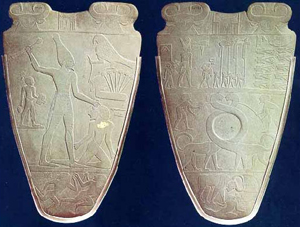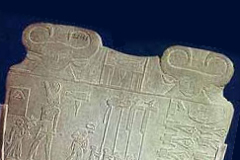|
Narmer
Pallette
|
 The
metallic edges around the palette are part of the modern-day
encasing used to make the palette stand upright The
metallic edges around the palette are part of the modern-day
encasing used to make the palette stand upright
|
Named
after the Horus Narmer, whose titulary appears on both its
faces, the Narmer Palette is a flat plate of schist about
64 centimetres in height. Its size, weight and decoration
suggest that it was a ceremonial palette.
The
Narmer Palette was found in Hierakonpolis, the ancient Pre-Dynastic
capital located in the south of Egypt, by the British archaeologist
J.E. Quibell during the excavation season of 1897/98. The
Palette was found along with other artefacts stemming from
the early beginnings of the recorded history of Ancient Egypt:
fragments of a ceremonial mace head belonging to Narmer and
some other mace head fragments inscribed with the name of
the Horus 'Scorpion', one of Narmer's predecessors. The exact
finding circumstances of the palette have not been noted and
there appears to be some contradictions in the publication
of Quibell's work at Hierakonpolis.
 The
palette's top
The
palette's top |
The
top of the palette is 'decorated' in a similar manner on both
sides: the name of the king is inscribed in a so-called serekh
in between two bovine heads
The
animal's heads are drawn from the front, which is rather uncharacteristic
of later Egyptian art. In most publications, these heads have
been described as cows' heads, interpreted as an early reference
to the cult of a cow-goddess, perhaps even Hathor. It is,
however, equally possible that the animals are bulls and that
they refer to the bull-like vigour of the king, a symbolism
that continues to be used throughout Ancient Egyptian history.
|

|
Back
- Central scene
Most
of the back of the palette is taken up by a finely carved
and highly detailed raised relief showing a king, undoubtedly
Narmer, ready to strike down a foe whom he grabs by the hair.
This pose would become typical in Ancient Egyptian art. He
wears a short skirt, an animal's tail and the White Crown
normally associated with Upper Egypt.
Behind
him an apparently bald person holds the king's sandals in
his left hand and a basket in his right. The signs written
behind this man's head may denote his title, but their exact
reading and meaning are unsure. The fact that the king is
represented as barefooted and followed by a sandal-bearer
perhaps suggests a ritual nature for the scene depicted on
the palette.
The
king's victim is kneeling before him, his arms flung next
to his body, as if to indicate that he was bound. Apart from
a girdle, he is represented naked. The contrast between the
naked victim and the clad king perhaps denotes that the victim
was considered barbaric. The two signs behind his head, probably
to be read as Wa-shi, could be the victim's name. If this
is indeed the case, then Narmer found him an opponent of such
importance that his name was to be perpetuated. It is not
entirely unlikely that this man was the leader of an important
group or community conquered by Narmer.
Above
the victim's head, facing the king, a personified marshland
is represented: the left side of a piece of land or swamp
is decorated with the head of a man, somewhat reminiscent
of Narmer's victim. Out of that land, 6 papyrus plants are
growing, indicating that this land was a marshland. A falcon,
symbol of the king, is perched on top of the papyrus plants
and appears to draw the breath of life out of the nostrils
of the marshland's face.
|
|